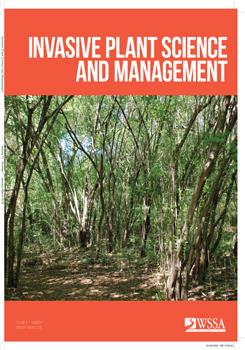Black swallowwort [Vincetoxicum nigrum (L.) Moench] and pale swallowwort [Vincetoxicum rossicum (Kleopow) Barb.] are perennial vines of European origin that invade natural areas and perennial cropping systems in the northeastern United States and southeastern Canada. Both species reproduce via wind-dispersed seeds in the form of achenes with comas, but little is known about the extent of dispersal of these seeds. We studied the relationship of seed release height (0.75m, 2 m), wind speed at the time of release, seed mass, and settling rate on distance traveled. Vincetoxicum nigrum and V. rossicum seeds traveled up to 72.1 and 79.6 m, respectively. Seeds of both species released from 2m traveled greater distances than seeds released from 0.75m, which fell within 20m of the release point. Release height was the most important factor influencing long-distance dispersal events. Wind speed also strongly interacted with release height for longdistance dispersal of V. nigrum. Vincetoxicum nigrum seed mass was greater and settling rates faster than for V. rossicum. Increasing seed mass generally increased settling rate, which in turn decreased distance traveled, except in V. rossicum, for which longer distance—dispersing seeds had a faster settling rate. Our findings suggest that management efforts focus on reducing the presence of these two vines, especially if there is potential for them to climb up taller vegetation such as trees. Seeds released from these greater heights are more likely to travel far from source populations and initiate new populations. Preventing seed production in small, nonclimbing patches will also help suppress the expansion of these two vines, as seeds can still disperse up to 20m away from parent plants.
How to translate text using browser tools
1 March 2018
Seed-Dispersal Ability of the Invasive Perennial Vines Vincetoxicum nigrum and Vincetoxicum rossicum
Antonio DiTommaso,
Courtney A. Stokes,
Stéphane Cordeau,
Lindsey R. Milbrath,
Thomas H. Whitlow
ACCESS THE FULL ARTICLE
dispersal kernel
dispersal modeling
dogstrangling vine
invasive species
seed dispersal
seed trait
settling rate






